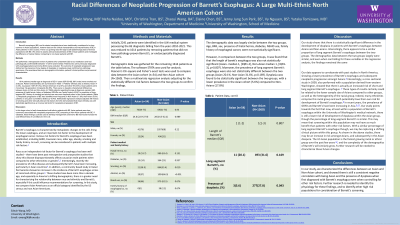Monday Poster Session
Category: Esophagus
P1850 - Racial Differences of Neoplastic Progression of Barrett’s Esophagus: A Large Multi-Ethnic North American Cohort
Monday, October 23, 2023
10:30 AM - 4:15 PM PT
Location: Exhibit Hall

Has Audio
- EW
Edwin Wang, MD
University of Washington
Seattle, Washington
Presenting Author(s)
Edwin Wang, MD, Neha Naidoo, MD, Christina Tran, BS, Zhaoyi Wang, BA, Elaine Chen, BS, Jenny Jung Sun Park, BS, Vy Nguyen, BS, Yutaka Tomizawa, MD
University of Washington, Seattle, WA
Introduction: Barrett’s esophagus (BE) and its related neoplasia have been traditionally considered to be less common in Asian populations, however data on the clinical characteristics and natural history of BE in Asian patients in US is scarce. There is a growing need for large-scale epidemiologic data of diverse populations with BE. We aimed to assess clinical characteristics of BE in Asian patients and investigate the difference of natural history comparing to non-Asian patients with BE.
Methods: We performed a retrospective review of patients who underwent EGD at our institutions and had pathologically confirmed BE between 1/1/2010 and 6/1/2022. Patients who were previously diagnosed with esophageal adenocarcinoma (EAC) were excluded. The outcome of neoplastic progression was defined as the presence of any degree of dysplasia or neoplasia newly confirmed on pathology specimens. We ascertained data on demographic information, patients’ clinical profiles and procedural characteristics.
Results: 1614 patients (median age at diagnosis of BE 61 years [IQR 53-68], 68% male) were enrolled and analyzed. Patient characteristics are summarized in Table 1. Patients’ ethnicity was as follows; Asian 54 (3.4%), Caucasian 1467 (91.0%), African American 34 (2.0%) and other 59 (3.6%). Asian patients were more likely 1st generation immigrants (64.8%). There were no baseline characteristic differences between Asian (n=54) and Non-Asian (n=1560) patients regarding the age at diagnosis, gender, BMI, presence of hiatal hernia, history of diabetes, NSAIDs use, family history of EAC or proportion of long-segment BE. History of smoking and alcohol use was more frequently seen in Non-Asian patients (Table 1). Neoplastic progression of BE was identified more frequently in Non-Asian (17.8%) than Asian (5.6%) patients on any given surveillance EGDs (p=0.043). Multivariate regression analysis adjusted with history of smoking and other clinically relevant risk factors for EAC demonstrated that Asian ethnicity was still statistically significant as an inverse risk factor for neoplastic progression of BE.
Discussion: In this large cohort of well-characterized multi-ethnic patients with BE, Asian patients were less commonly associated with neoplastic progression of BE comparing to Non-Asian patients with BE. If validated, these findings could be used to develop management schema for BE that would increase the cost-effectiveness of surveillance in the U.S.
Disclosures:
Edwin Wang, MD, Neha Naidoo, MD, Christina Tran, BS, Zhaoyi Wang, BA, Elaine Chen, BS, Jenny Jung Sun Park, BS, Vy Nguyen, BS, Yutaka Tomizawa, MD. P1850 - Racial Differences of Neoplastic Progression of Barrett’s Esophagus: A Large Multi-Ethnic North American Cohort, ACG 2023 Annual Scientific Meeting Abstracts. Vancouver, BC, Canada: American College of Gastroenterology.
University of Washington, Seattle, WA
Introduction: Barrett’s esophagus (BE) and its related neoplasia have been traditionally considered to be less common in Asian populations, however data on the clinical characteristics and natural history of BE in Asian patients in US is scarce. There is a growing need for large-scale epidemiologic data of diverse populations with BE. We aimed to assess clinical characteristics of BE in Asian patients and investigate the difference of natural history comparing to non-Asian patients with BE.
Methods: We performed a retrospective review of patients who underwent EGD at our institutions and had pathologically confirmed BE between 1/1/2010 and 6/1/2022. Patients who were previously diagnosed with esophageal adenocarcinoma (EAC) were excluded. The outcome of neoplastic progression was defined as the presence of any degree of dysplasia or neoplasia newly confirmed on pathology specimens. We ascertained data on demographic information, patients’ clinical profiles and procedural characteristics.
Results: 1614 patients (median age at diagnosis of BE 61 years [IQR 53-68], 68% male) were enrolled and analyzed. Patient characteristics are summarized in Table 1. Patients’ ethnicity was as follows; Asian 54 (3.4%), Caucasian 1467 (91.0%), African American 34 (2.0%) and other 59 (3.6%). Asian patients were more likely 1st generation immigrants (64.8%). There were no baseline characteristic differences between Asian (n=54) and Non-Asian (n=1560) patients regarding the age at diagnosis, gender, BMI, presence of hiatal hernia, history of diabetes, NSAIDs use, family history of EAC or proportion of long-segment BE. History of smoking and alcohol use was more frequently seen in Non-Asian patients (Table 1). Neoplastic progression of BE was identified more frequently in Non-Asian (17.8%) than Asian (5.6%) patients on any given surveillance EGDs (p=0.043). Multivariate regression analysis adjusted with history of smoking and other clinically relevant risk factors for EAC demonstrated that Asian ethnicity was still statistically significant as an inverse risk factor for neoplastic progression of BE.
Discussion: In this large cohort of well-characterized multi-ethnic patients with BE, Asian patients were less commonly associated with neoplastic progression of BE comparing to Non-Asian patients with BE. If validated, these findings could be used to develop management schema for BE that would increase the cost-effectiveness of surveillance in the U.S.
Disclosures:
Edwin Wang indicated no relevant financial relationships.
Neha Naidoo indicated no relevant financial relationships.
Christina Tran indicated no relevant financial relationships.
Zhaoyi Wang indicated no relevant financial relationships.
Elaine Chen indicated no relevant financial relationships.
Jenny Jung Sun Park indicated no relevant financial relationships.
Vy Nguyen indicated no relevant financial relationships.
Yutaka Tomizawa: Boston Scientific Company – Consultant. Medtronic – Consultant.
Edwin Wang, MD, Neha Naidoo, MD, Christina Tran, BS, Zhaoyi Wang, BA, Elaine Chen, BS, Jenny Jung Sun Park, BS, Vy Nguyen, BS, Yutaka Tomizawa, MD. P1850 - Racial Differences of Neoplastic Progression of Barrett’s Esophagus: A Large Multi-Ethnic North American Cohort, ACG 2023 Annual Scientific Meeting Abstracts. Vancouver, BC, Canada: American College of Gastroenterology.
